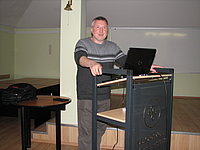Peculiarities of quartz fiber manufacturing for power applications in SIA Ceram Optec
Andrey Grishchenko, Head of R&D Department of Ceramoptec, Latvia, Dmitry Saharov, Laboratory Manager in R&D Department, Ceramoptec, Latvia
Ceram Optec SIA has united a complete cycle of the power optical fiber manufacturing "under one roof". This cycle involves preforms deposition, fiber drawing, production of different medical and technical products, made out of these fibers. Main directions of production activities of Ceramoptec SIA are discussed.
A distinctive feature of the company is the utilization of two plasma technologies for the production of quartz/quartz preforms (POVD, PCVD). These technologies allow the deposition of pure quartz with zero content of fluorine as well as fluorine doped with concentration up to 9at% (NA = 0,3). The feature of the plasma technologies is very high gradient of process parameters in deposition area. Equilibrated concentrations of chemicals are not reached and this could help to explain ability to increase the fluorine content for more than three times compared with theoretically calculated in equilibrated conditions and achieved by flame technologies. So according to the literature the maximum concentration of fluorine in quartz achieved by means of MCVD is 2,5at.% ( NA = 0,15) [1]. Different technologies of fluorinated quartz deposition are discussed and compared.
Growth in demand for power quartz fibers and fiber optics products, operating in the UV region of the spectrum, imposes requirements on resistance to solarization. Effect of increasing the gray losses with time of operation of the fiber products is discussed. The mechanisms of grows of gray losses, their dependence on the composition of the quartz glasses and methods for its treatment are presented.
Ceram Optec SIA is continuously working to improve the processes and manufactured products. The main directions of company’s development are presented.
1. Abe k. Fluorine doped silica for optical waveguides. II European Conference on Optical Communication. Paris, 1976.p.59-61.
